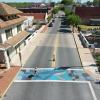Art Trembanis is a geology professor at the University of Delaware’s School of Marine Science. He focuses on how waves, tides and wind currents shape the beach and seabed. Simply put, move sand around. What geologists call ‘coastal morphodynamics.’
We are at Herring Point, Cape Henlopen State Park, low tide. The beach is at its widest. From atop this spot adjacent to the gun battery, he scans the horizon.
“The instinct of most people is to regard sea levels and land boundaries as intractable. Inviolable. But the ‘status quo’ of the system is continually shifting; the reality is that the sea level goes through periods of being much higher and much lower.”
Art motions southward to a World War II observation tower. From our vantage point, it teeters precariously near the surf. Then, making his point about the changing landscape, he produces a photograph from the 1930s of the same tower safely ensconced several hundred yards back from the ocean. The coast is eroding at an average rate of approximately 4 feet per year.
“190 million years ago, you could have walked from here to Morocco. Behind us are the remains of a mountain range (the Appalachians) that rivaled the Himalayas. Fifteen thousand years ago, at the end of the last ice age, the climate here was comparable to the north slope of Alaska. Delaware Bay is a drowned river valley. The Delaware River would have been running past us for another 70 miles where the sea level was about 300 feet lower.”
We’re standing atop the Great Dune, Henlopen’s crown jewel, the tallest sand dune between Cape Cod and Nags Head. That’s why the army set up its guns here, to command the heights and defend merchant shipping from German submarines. The Great Dune is a natural phenomenon. Art, however, refers to it as the Great Galloping Dune because it’s migrating. Slowly blowing away.
Winds are carrying off its foundations which have been destabilized by surrounding construction and tree removal. A broad stream of darker water, several hundred yards offshore, holds his gaze.
“The bay merging with the ocean creates a trackable plume 50 miles long down the Delmarva Peninsula.” Submerged ridges form, 50 feet below the surface at the deepest spot. This is the Hen and Chicken Shoals.
“The effect on the ocean passing over them is like subtle speed-bumps. That’s why waves break here and why surfers hang out here.” We descend to the beach. He scoops up a handful of dune sand. To me the grains are indistinguishable until he points out tiny differences in size, color and coarseness. The older the sand, the smoother it becomes. “The sand here isn’t good for construction; it’s too smooth to adhere.”
Henlopen is the product of a ‘long-shore drift system.’ Over eons, southern winds and current deposit sand that forms the beaches of Herring Point and Cape Henlopen spit. This pattern changes at Fenwick Island, the coastal “nodal point,” where the drift switches direction and beaches build up from the north. “The essence of this beach’s geology is an ancient history of being worked and re-worked.”
Darkish patches of sand arouse my curiosity. Residue from oil spills? “No, heavy minerals. Minerals wash up in the waves and are too dense to float back out with the tide.
Over time, the lighter surface particles cohere into a salt spray crust called salcrete. More sand gathers atop. Then another crust forms, trapping the accumulated sand.” Art digs a hole several feet deep to reveal successive strata of bands below the surface. “That’s how beaches build up.” As our walk ends, I ask him point-blank: “What do you love about the beach?”
The question causes him to reflect before answering.
“The fact that it’s still confounding, that I haven’t completely figured it out. It’s like a watch, you know all the component parts but every so often it spins out of direction. It’s familiar but there are facets I don’t know.”
Then, after a pause, he strikes a metaphysical note which sums up the wonder the beach holds for him: “My kids can come here with their kids but it will be further back. The same but different.”




















































